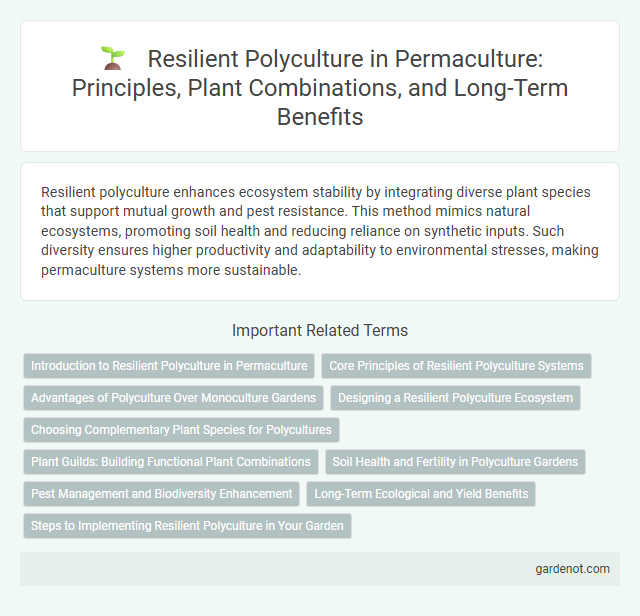Resilient polyculture enhances ecosystem stability by integrating diverse plant species that support mutual growth and pest resistance. This method mimics natural ecosystems, promoting soil health and reducing reliance on synthetic inputs. Such diversity ensures higher productivity and adaptability to environmental stresses, making permaculture systems more sustainable.
Introduction to Resilient Polyculture in Permaculture
Resilient polyculture in permaculture integrates diverse plant species to mimic natural ecosystems, enhancing soil health and biodiversity while reducing vulnerability to pests and diseases. This approach fosters ecological balance through complementary interactions between plants, animals, and microorganisms, promoting sustainability and long-term productivity. Emphasizing resource efficiency and adaptive management, resilient polyculture strengthens system stability under environmental stresses such as drought or climate variability.
Core Principles of Resilient Polyculture Systems
Resilient polyculture systems emphasize biodiversity, soil health, and synergistic plant relationships to enhance ecosystem stability and productivity. Core principles include maintaining species diversity, promoting natural pest control, and optimizing nutrient cycling through complementary plant interactions. These strategies increase resilience against environmental stressors, ensuring sustainable yields in permaculture landscapes.
Advantages of Polyculture Over Monoculture Gardens
Polyculture gardens enhance biodiversity by cultivating multiple plant species simultaneously, which improves pest resistance and soil health compared to monoculture systems. The diverse root structures in polyculture promote nutrient cycling and prevent erosion, leading to more stable and productive ecosystems. This resilient approach reduces reliance on chemical inputs and supports sustainable food production in permaculture designs.
Designing a Resilient Polyculture Ecosystem
Designing a resilient polyculture ecosystem involves integrating diverse plant species that enhance soil health, improve pest resistance, and optimize resource use efficiency. Key principles include selecting complementary species with varying root depths and growth habits to create a balanced nutrient cycle and microclimate regulation. Incorporating perennial plants, nitrogen-fixers, and dynamic accumulators fosters ecosystem stability and long-term productivity in permaculture landscapes.
Choosing Complementary Plant Species for Polycultures
Choosing complementary plant species for resilient polyculture maximizes biodiversity and resource efficiency by combining nitrogen-fixing legumes, deep-rooted perennials, and nutrient-accumulating plants. Selecting species with varied root depths and growth habits enhances soil structure, reduces pest pressure, and improves microclimate stability. Effective polyculture design increases ecosystem resilience, promotes sustainable yields, and supports long-term soil health.
Plant Guilds: Building Functional Plant Combinations
Resilient polyculture leverages plant guilds to create synergistic combinations that enhance ecosystem productivity and stability. By integrating nitrogen-fixing plants, dynamic accumulators, and pest-repellent species, these functional plant guilds optimize nutrient cycling and improve soil health. This strategic layering of complementary species increases biodiversity and resilience against pests, diseases, and environmental stressors in permaculture systems.
Soil Health and Fertility in Polyculture Gardens
Resilient polyculture gardens enhance soil health and fertility by promoting diverse plant species that improve nutrient cycling and organic matter content. Deep-rooted perennials and nitrogen-fixing legumes increase microbial activity and soil structure, fostering a balanced ecosystem resistant to pests and erosion. Integrating cover crops and mulching further maintains moisture retention and reduces nutrient loss, ensuring long-term productivity and sustainability.
Pest Management and Biodiversity Enhancement
Resilient polyculture integrates diverse plant species to create balanced ecosystems that naturally suppress pests through habitat complexity and predator-prey relationships, reducing reliance on chemical inputs. Enhancing biodiversity within these systems supports beneficial insects, pollinators, and soil microorganisms, which collectively improve pest resistance and soil health. This approach fosters sustainable pest management by leveraging ecological processes and maintaining ecosystem stability.
Long-Term Ecological and Yield Benefits
Resilient polyculture systems enhance soil health by promoting biodiversity, which improves nutrient cycling and pest resistance over time. Diverse plant species in these systems create microclimates that stabilize yields against climate variability and reduce dependency on chemical inputs. Long-term ecological benefits include increased carbon sequestration and habitat restoration, while sustained yield improvements support food security and farm profitability.
Steps to Implementing Resilient Polyculture in Your Garden
Start by selecting diverse, complementary plant species that support each other's growth and improve soil health, such as nitrogen-fixing legumes, nutrient accumulators, and pest-repellent herbs. Design your garden layout to mimic natural ecosystems with layered plantings, incorporating ground covers, shrubs, and trees to enhance biodiversity and resilience. Regularly observe and adjust species combinations based on plant performance and environmental conditions to maintain balance and optimize productivity.
Resilient polyculture Infographic

 gardenot.com
gardenot.com